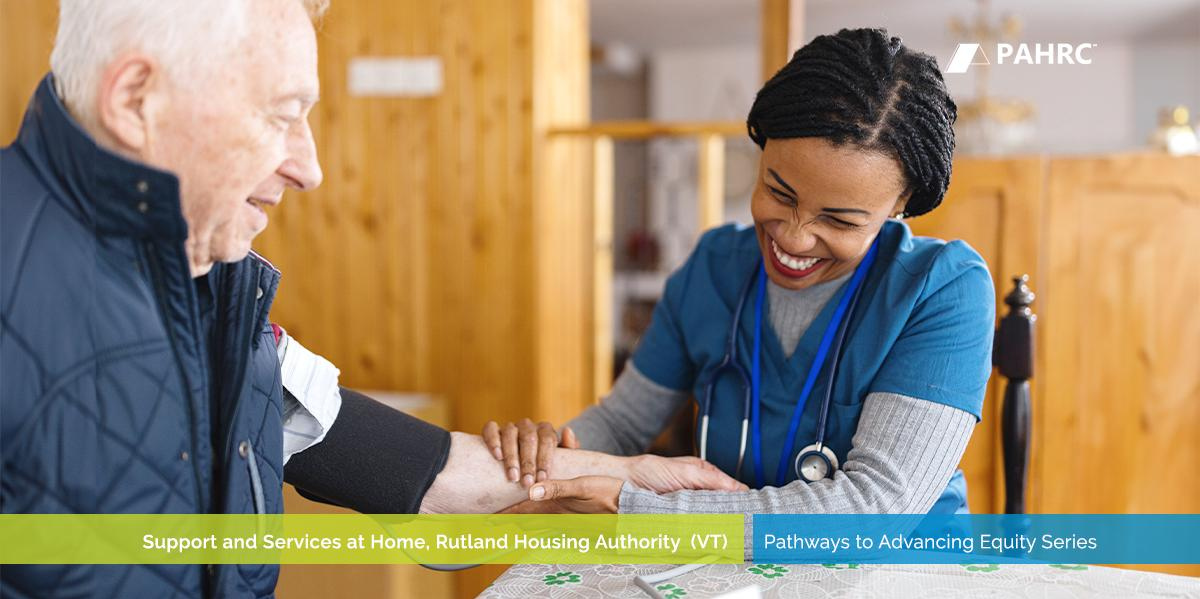Research Case Study: Rutland Housing Authority Integrates Support Program for Elderly Population

Written by Mike Torelli, Senior Marketing Specialist for HAI Group.
Shared courtesy of HAI Group.
For many senior citizens, the thought of where they will spend their golden years can be concerning. Will they be able to stay in their home, aging comfortably surrounded by loved ones and their belongings? Or will they be forced to move to a retirement home due to physical restrictions?
Rutland Housing Authority (RHA), a public housing authority in Vermont, implemented Support and Services at Home (SASH), a program that provides health intervention to its elderly population to ensure they have a fair chance at living where they want. Since the program's inception, RHA has made a major difference for seniors in their community by supporting them in their own homes.
RHA featured in “PHA Pathways for Advancing Equity,” a new report released by the Public and Affordable Housing Research Corporation (PAHRC), a member of HAI Group’s family of companies.
Challenge
Many seniors face the difficult decision of whether to stay in their homes or move to a retirement facility due to health and mobility issues. This challenge is compounded by the need for regular health assessments and support services to manage chronic conditions and overall well-being.
Solution
In 2009, Cathedral Square, an affordable housing provider in Vermont, created SASH, a community-based health initiative that helps thousands of older adults living in affordable properties statewide. SASH aims to improve health outcomes for older adults and helps them age in place by providing health and wellness assessments, care plans, care coordination, and health programs. It is a voluntary program that is free to participants.
RHA integrated the program into its organization in 2011. While this is a Medicare program, RHA also helps those without Medicare get involved in the SASH network.
Implementation
SASH puts participants into panels—groups of 70-100 people—based on residence or their Medicare plan. Each panel is assigned a care coordinator and nurse who work with each participant to complete a health assessment, identify their goals, and create a health plan. The SASH team develops relationships with each participant by providing the following services:
- Wellness check-ins and health coaching on chronic conditions.
- Help with developing systems to manage medications.
- Planning for successful transitions to and from hospitals or nursing homes.
- Help with scheduling medical appointments and completing advance directives.
- Initiatives to reduce isolation and support mental health, which increased during the COVID-19 pandemic.
- Regular blood pressure clinics.
- One-on-one and group education about hypertension prevention and management.
- Work with primary care physicians to ensure that participants’ medications and interventions are current.
SASH team members also provide care and medication management to participants who return home from hospital visits. This assistance helps participants manage the emotional transition home and mitigates the risk of post-hospitalization infections and resurgent health conditions.
“We had an individual that was receiving services [through SASH] that the nurse identified as having blood pressure that was dangerously high—they ended up taking him immediately to the hospital. The feedback from the hospital was that he was not going to survive this without the intervention. Ultimately, they were able to identify the health concern in the short term and treat it long term. The individual is forever grateful because they didn’t even realize." RHA
Across each panel, staff track aggregate concerns to identify areas where residents may need more education or support. Having quantifiable results based on independent assessments also helps them show partners, staff, and stakeholders that they are assisting their residents effectively and meaningfully.
Impact
As of the beginning of 2024, there have been more than 12,000 participants of SASH, 140 housing sites, and 70 statewide partners. RHA recruits participants for the program through word of mouth, outreach events, advertisements, and referrals. SASH serves up to 5,000 Vermont residents at any given time.
Since its implementation, SASH has seen increased healthcare savings and preventative health actions among participants. Long-established participants are estimated to have saved over $1,000 annually in Medicare expenses. Dually enrolled SASH participants also had Medicaid expenditures that were $400 lower per year than their unassisted peers.
In addition to financial savings, SASH participants have increased vaccination rates, advance directives, and hypertension mitigation, exceeding the national average among older adults across these health metrics. Between 2016-2017, SASH increased the percentage of participants who had their hypertension under control by 10%, advance directives by 7%, pneumococcal and flu vaccinations by 6%, and shingles vaccinations by 5%.
SASH participants also fall less often. In 2017, only 26% experienced a fall, compared to the national average of 32%. According to a 2017 SASH survey, participants also noted less difficulty managing their medications, higher overall functional status, and greater awareness of the relationship between nutrition and health.
SASH for All, a federally funded pilot initiative, expanded SASH services to low-income residents of any age with or without disabilities living in affordable housing in rural Brattleboro, VT. SASH for All is voluntary and free.
Conclusion
The SASH program at RHA has significantly improved the quality of life for many senior residents, allowing them to age in place with dignity and independence. By providing comprehensive health and wellness support, RHA is ensuring that seniors can live comfortably in their own homes.
For more detailed insights and similar case studies, refer to “PHA Pathways for Advancing Equity,” a report by the Public and Affordable Housing Research Corporation (PAHRC), a member of HAI Group’s family of companies.